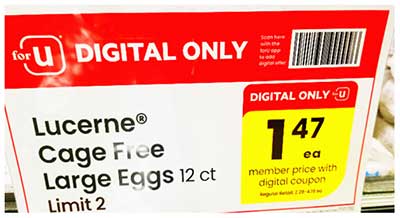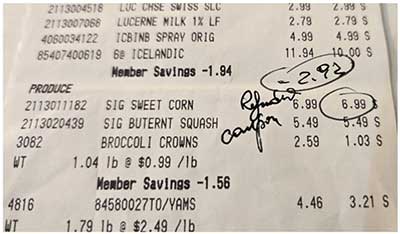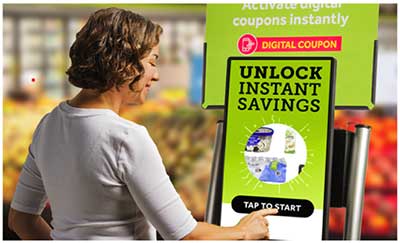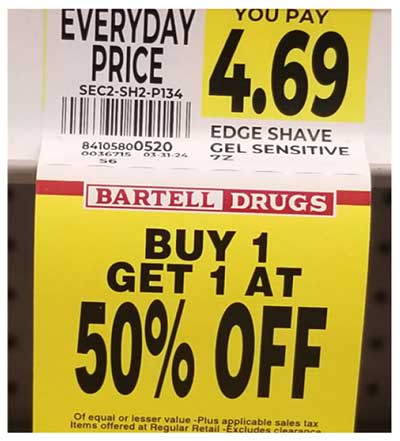Last updated February 2025

I am not your typical supermarket shopper. After checking out, instead of heading to my car, I pull my cart to the side and review the receipt.
Why? Because experience has taught me that I often don’t get charged the correct sale prices when I use digital coupons. Sometimes these overcharges are small, sometimes they’re substantial. All are annoying. And each mistake takes time to correct.
Listen to audio highlights of the story below:
 A few examples:
A few examples:
- Strawberries were on sale for $2.88/container, but I was charged the regular price ($4.49)—an overring of $1.61.
- I scanned a shelf tag with my phone to get the “digital only” price for eggs, $1.47/dozen. (Yes, this was a while ago!) I was charged the full price ($3.49), for an overcharge of $2.02.
- Grapes were on sale for $1.27 per pound. I should have been charged $2.74 for the bag I bought. Instead, it rang up at full price ($3.99/lb.), a mistake totaling $5.88.
Some of these sales are advertised as good for the entire month, which meant I was overcharged for the same item over and over. One example: Sweet onions were on sale for $1.13 per pound in December. The coupon clearly stated, “unlimited use.” And yet I was charged full price at checkout for several purchases that month. One time, I was overcharged $1.99 for just two onions!
I’ve had trouble with my digital coupons for nearly a year at various Safeway stores in the Seattle area, regardless of whether I used self-checkout or went through the checkout line. Safeway is owned by Albertsons, which also operates supermarket chains Andronico’s, Acme, Haggen, Jewel-Osco, Lucky, Randall’s, Shaw’s, Star, Vons, and United Supermarkets.
For decades, grocery stores have given lower prices on certain items to people who sign up for their club cards. The industry is now moving quickly toward offering additional discounts that customers must access online, often by using the stores’ mobile apps. Shoppers can “clip” these digital coupons by manually adding them to their accounts or scanning barcodes on shelf tags. The discounts are supposed to get applied automatically at checkout.
 Before heading to the grocery, I usually “clip” the digital coupons on my home computer and then print out the list as proof of available discounts. But even that extra step sometimes isn’t enough for Safeway. One time a manager, who seemed annoyed that I was asking for a refund, would not accept my printout of clipped coupons as evidence of the discount price. He made me launch the app on my phone to show him the coupon. He made me feel stupid, like I didn’t know how to clip the coupons. Another time, the person working the self-checkout line told my wife she’d better figure out how to use her phone, if she wanted to get the lower prices.
Before heading to the grocery, I usually “clip” the digital coupons on my home computer and then print out the list as proof of available discounts. But even that extra step sometimes isn’t enough for Safeway. One time a manager, who seemed annoyed that I was asking for a refund, would not accept my printout of clipped coupons as evidence of the discount price. He made me launch the app on my phone to show him the coupon. He made me feel stupid, like I didn’t know how to clip the coupons. Another time, the person working the self-checkout line told my wife she’d better figure out how to use her phone, if she wanted to get the lower prices.
Several times, while I waited for a customer service person to verify that I had “clipped” the coupon and calculate the refund, I expressed my frustration with the system.
One customer service rep, who told me she had worked for Safeway for 25 years, said, “This is what we do all day long, fix prices.” When asked if she told management about the problem, she replied, “I’ve expressed my discontent, but nothing happens.”
I contacted Albertson’s to find out why this was happening. The company sent back this statement:
“Albertsons Companies constantly monitors customer feedback to ensure a high level of satisfaction and is aware of the issues preventing some digital offers from being applied at checkout. We believe these issues have affected less than 0.5% of customers who have clipped and redeemed coupons nationwide, and we are actively working on solutions to ensure all customers receive the full benefit of our digital offers. Any shopper who has experienced an issue with their digital offers can contact Albertsons Cos. customer service at (877) 723-3929 for assistance.”
It's Not an Isolated Problem
This coupon problem is not limited to Safeway stores in my area. Guy and Rebecca, a retired couple who shop at a Kroger near their home in Batesville, Ind., told me they’re frustrated with the store’s digital coupon program and its constant mistakes. (Kroger owns Food 4 Less, Foods Co., Fred Meyer, Fry’s, Harris Teeter, King Soopers, Mariano’s, Metro Market, Pick ’n Save, QFC, Ralphs, and several other smaller supermarket chains.)
Guy said his blood pressure goes up each time he spots a mistake, and the checker says he’ll need to go to customer service.
“I think, why do I have to go through this?” Guy said. “I go up to [the customer service counter] it’s like they’re so used to this now. It’s almost like the system is designed not to give people the proper credit.”
Checkbook subscribers told us about similar problems at stores operated by Albertsons and Kroger, plus at Giant Food. And some have reported trouble getting correct Prime-only discounts at Whole Foods.
One subscriber told us it’s “especially annoying being made to stand in a (long) line at customer service” and being given “some bogus explanation that the shelf price was wrong and won’t be honored.” It’s like they’re “hoping I will just give up and leave,” he said. “You would think that scanning and computerizing all of this would solve this problem, but it hasn’t.”
Kroger did not respond to Checkbook’s requests for comments.
Why Is This Happening?
I can’t say for sure, but computer programming errors would seem to be the most likely culprit. Whatever the reason, these errors are costing consumers money.
“It’s always in their favor, right? It’s never in your favor,” said Lisa Lee Freeman, a consumer and shopping expert. “I think it’s important to hold the store accountable and make sure you’re getting the discounts you deserve…because over the course of a year, it could save you a lot of money if you’re really on top of this.”
When Checkbook asked the Food Marketing Institute, a trade group that represents supermarkets, about these issues we were told they did not have any information to share.
In some cases, the overcharges might be deliberate. In October, Albertsons, Safeway, and Vons agreed to pay $3.9 million to settle a law enforcement complaint in California alleging that their stores engaged in “false advertising and unfair competition.”
The complaint alleged the grocers “unlawfully charged customers prices higher than their lowest advertised or posted price.”
The judgment prohibits the three chains from engaging in various false or misleading advertising practices in California, including failure to disclose exclusions in the “Just for U” or “Club Card” programs.
The grocers must also implement a “price accuracy guarantee” policy in the state that provides compensation of up to $5 when customers are overcharged.
Digital Discounts Are Too Difficult to Use
Millions of Americans can’t access supermarket’s digital discounts. Ten percent of adults in the U.S. (25 million people) don’t have smartphones; 20 percent (50 million) don’t have home broadband, according to a survey last year by the Pew Research Center.
This “digital discrimination” disproportionately hurts lower-income families and older adults, who need the discounts the most.
“What about these shoppers?” asked Teresa Murray, director of the Consumer Watchdog office at U.S. PIRG. “They deserve to save money, too.”
Checkbook subscribers complain that it’s often challenging to scan the bar code on a shelf tag or sale sign with their smartphone. As I’ve discovered on numerous occasions, scanning the code does not always mean the discount is loaded into your app.
Candace, a subscriber who lives in Glen Ellyn, Ill., calls Jewel’s app “a major pain in the neck” that constantly results in overcharges. She and her husband now sit in their car in the parking lot and check the receipt before they leave.
“And probably 50 percent of the time, we have to go back in, and they adjust the price. You assume it’s digital; it’s a computer; takes care of everything. And the people in the store tell us they don’t like it either.”
It’s Not Automatic
Signs and shelf tags offering digital discounts in the store have barcodes or QR codes. This suggests you can simply scan the code to get the discount. It typically doesn’t work that way.
“It’s not automatic,” said Edgar Dworsky, publisher of ConsumerWorld.org. “There are at least one or two more steps you must go through.”
Sometimes, scanning brings up the specific item on the app, but you still need to electronically clip it. Sometimes, you’re taken to a page filled with all the discounts available that day.
“Now, you have to go through the whole list of coupons and try to find the right one,” Dworsky noted. “Why are they making it so difficult to get the advertised savings?”
 Dworsky gave a shout-out to Stop & Shop, a Northeast chain, for installing digital coupon kiosks at the front of its stores. Customers simply scan their loyalty cards or enter their phone numbers at the “Savings Station,” and all that week’s advertised digital coupons are automatically loaded onto their accounts.
Dworsky gave a shout-out to Stop & Shop, a Northeast chain, for installing digital coupon kiosks at the front of its stores. Customers simply scan their loyalty cards or enter their phone numbers at the “Savings Station,” and all that week’s advertised digital coupons are automatically loaded onto their accounts.
“While it’s no guarantee the discount will actually be deducted at checkout, at least it rules out shopper error as a reason the savings don’t get applied,” Dworsky said. “I hope other stores follow Stop & Shop’s lead.”
Want the Best Prices? You’ll Probably Have to Complain
Checkbook staffer Jamie Lettis always checks her receipt before she leaves the store. Frequently, she finds mistakes.
“Unfortunately, it’s on the consumer to make sure they received those advertised deals,” Lettis said. “Yes, it’s a pain, but it’s the only way to ensure you weren’t cheated.”
Whether you choose self-checkout kiosks or go through the checkout lane, watch the register display. Some stores don’t display the discounts until all the items are scanned, which makes it difficult or impossible to see what’s happening, but sometimes you can catch a mistake.
“You really need to make sure those discounts are being registered, and if they’re not you need to complain,” shopping expert Freeman told Checkbook.
If you manage your digital coupons before you go to the store, it’s easy to forget which ones you clipped. Freeman puts a star next to the items on her shopping list that are on sale. That makes it easier to check the register receipt. And she always checks.
For in-store sales, Freeman takes a picture of the shelf tag. Doing that can reduce the time waiting for a price check if the item doesn’t scan properly.
 I started doing this after having an overcharge on shaving cream that was on sale at a drugstore owned by Rite Aid. The shelf tag said, “BUY 1 Get 1 at 50% off.” But it rang up as two containers at full price. The clerk had to shut down the register, go to the aisle, examine the price tag, and then manually enter the discount code. He was very nice, but it wasted a lot of my time.
I started doing this after having an overcharge on shaving cream that was on sale at a drugstore owned by Rite Aid. The shelf tag said, “BUY 1 Get 1 at 50% off.” But it rang up as two containers at full price. The clerk had to shut down the register, go to the aisle, examine the price tag, and then manually enter the discount code. He was very nice, but it wasted a lot of my time.
“I’ve had times where I bought three cases of soda to get one free, but I didn’t see the discount on the display, so I alerted the clerk, and she fixed it,” said Checkbook’s Lettis. “This happens a lot. So, don’t assume the register will always get it right. You need to check.”
Getting digital discounts is such a pain that Kevin Brasler, Checkbook’s executive editor, said “I don’t even bother anymore. To me, getting these discounts has become more trouble than they’re worth.”
Of course, getting customers like Kevin to surrender their savings might be the whole strategy.
Contributing editor Herb Weisbaum (“The ConsumerMan”) is an Emmy award-winning broadcaster and one of America's top consumer experts. He has been protecting consumers for more than 40 years, having covered the consumer beat for CBS News, The Today Show, and NBCNews.com. You can also find him on Facebook, Twitter, and at ConsumerMan.com.


